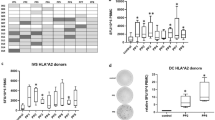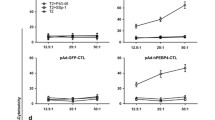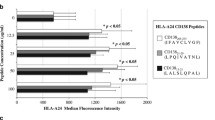Abstract
Hydroxysteroid (17β) dehydrogenase type 12 (HSD17B12) is a multifunctional isoenzyme functional in the conversion of estrone to estradiol (E2), and elongation of long-chain fatty acids, in particular the conversion of palmitic to archadonic (AA) acid, the precursor of sterols and the inflammatory mediator, prostaglandin E2. Its overexpression together with that of COX-2 in breast carcinoma is associated with a poor prognosis. We have identified the HSD17B12114–122 peptide (IYDKIKTGL) as a naturally presented HLA-A*0201 (HLA-A2)-restricted CD8+ T-cell-defined epitope. The HSD17B12114–122 peptide, however, is poorly immunogenic in its in vitro ability to induce peptide-specific CD8+ T cells. Acting as an “optimized peptide”, a peptide (TYDKIKTGL), which is identical to the HSD17B12114–122 peptide except for threonine at residue 1, was required for inducing in vitro the expansion of CD8+ T-cell effectors cross-reactive against the HSD17B12114–122 peptide. In IFN-γ ELISPOT assays, these effector cells recognize HSD17B12114–122 peptide-pulsed target cells, as well as HLA-A2+ squamous cell carcinoma of the head and neck (SCCHN) and breast carcinoma cell lines overexpressing HSD17B12 and naturally presenting the epitope. Whereas growth inhibition of a breast carcinoma cell line induced by HSD17B12 knockdown was only reversed by AA, in a similar manner, the growth inhibition of the SCCHN PCI-13 cell line by HSD17B12 knockdown was reversed by E2 and AA. Our findings provide the basis for future studies aimed at developing cancer vaccines for targeting HSD17B12, which apparently can be functional in critical metabolic pathways involved in inflammation and cancer.






Similar content being viewed by others
References
Moeller G, Adamski J (2009) Integrated view on 17beta-hydroxysteroid dehydrogenases. Mol Cell Endocrinol 301:7–19
Nagasaki S, Miki Y, Akahira J, Suzuki T, Sasano H (2009) Transcriptional regulation of 17beta-hydroxysteroid dehydrogenase type 12 by SREBP-1. Mol Cell Endocrinol 307:163–168
Luu-The V, Tremblay P, Labrie F (2006) Characterization of type 12 17ß-hydroxysteroid dehydrogenase, an isoform of type 3 17ß-hydroxysteroid dehydrogenase responsible for estradiol formation in women. Mol Endocrinol 20:437–443
Moon YA, Horton JD (2003) Identification of two mammalian reductases involved in the two-carbon fatty acyl elongation cascade. J Biol Chem 278:7335–7343
Harizi H, Corcuff JB, Gualde N (2008) Arachidonic-acid derived eicosanoids: roles in biology and immunopathology. Trends Mol Med 14:461–469
Sakurai N, Miki Y, Suzuki T, Watanabe K, Narita T, Ando K, Yung TM, Aoki D, Sasano H, Handa H (2006) Systemic distribution and tissue localizations of human 17beta-hydroxysteroid dehydrogenase type 12. J Steroid Biochem Mol Biol 99:174–181
Bellemare V, Laberge P, Noël S, Tchernof A, Luu-The V (2009) Differential estrogenic 17beta-hydroxysteroid dehydrogenase activity and type 12 17beta-hydroxysteroid dehydrogenase expression levels in preadipocytes and differentiated adipocytes. J Steroid Biochem Mol Biol 114:129–134
Rantakari P, Lagerbohm H, Kaimainen M, Suomela JP, Strauss L, Sainio K, Pakarinen P, Poutanen M (2010) Hydroxysteroid (17{beta}) dehydrogenase 12 is essential for mouse organogenesis and embryonic survival. Endocrinology 151:1893–1901
Bellemare V, Phaneuf D, Luu-The V (2010) Target deletion of the bifunctional type 12 17b-hydroxysteroid dehydrogenase in mice results in reduction of androgen and estrogen levels in heterozygotes and embryonic lethality in homozygotes. Horm Biol Clin Investig 2:311–318
Ito K, Utsunomiya H, Suzuki T, Saitou S, Akahira J, Okamura K, Yaegashi N, Sasano H (2006) 17Beta-hydroxysteroid dehydrogenases in human endometrium and its disorders. Mol Cell Endocrinol 248:136–140
Song D, Liu G, Luu-The V, Zhao D, Wang L, Zhang H, Xueling G, Li S, Désy L, Labrie F, Pelletier G (2006) Expression of aromatase and 17beta-hydroxysteroid dehydrogenase types 1, 7 and 12 in breast cancer. An immunocytochemical study. J Steroid Biochem Mol Biol 101:136–144
Fournier MA, Poirier D (2009) Estrogen formation in endometrial and cervix cancer cell lines: involvement of aromatase, steroid sulfatase and 17beta-hydroxysteroid dehydrogenases (types 1, 5, 7 and 12). Mol Cell Endocrinol 301:142–145
Day JM, Foster PA, Tutill HJ, Parsons MF, Newman SP, Chander SK, Allan GM, Lawrence HR, Vicker N, Potter BV, Reed MJ, Purohit A (2008) 17beta-hydroxysteroid dehydrogenase Type 1, and not Type 12, is a target for endocrine therapy of hormone-dependent breast cancer. Int J Cancer 122:1931–1940
Nagasaki S, Suzuki T, Miki Y, Akahira J, Kitada K, Ishida T, Handa H, Ohuchi N, Sasano H (2009) 17Beta-hydroxysteroid dehydrogenase type 12 in human breast carcinoma: a prognostic factor via potential regulation of fatty acid synthesis. Cancer Res 69:1392–1399
Rickman DS, Millon R, De Reynies A, Thomas E, Wasylyk C, Muller D, Abecassis J, Wasylyk B (2008) Prediction of future metastasis and molecular characterization of head and neck squamous-cell carcinoma based on transcriptome and genome analysis by microarrays. Oncogene 27:6607–6622
Hendrickson RC, Cicinnati VR, Albers A, Dworacki G, Gambotto A, Pagliano O, Tüting T, Mayordomo JI, Visus C, Appella E, Shabanowitz J, Hunt DF, DeLeo AB (2010) Identification of a 17beta-hydroxysteroid dehydrogenase type 12 pseudogene as the source of a highly restricted BALB/c Meth A tumor rejection peptide. Cancer Immunol Immunother 59:113–124
Heo DS, Snyderman C, Gollin SM, Pan S, Walker E, Deka R, Barnes EL, Johnson JT, Herberman RB, Whiteside TL (1989) Biology, cytogenetics, and sensitivity to immunological effector cells of new head and neck squamous cell carcinoma lines. Cancer Res 49:5167–5175
Latimer JJ (2000) U.S. patent #6074874. Epithelial cell cultures useful for in vitro testing
Tsujisaki M, Sakaguchi K, Igarashi M, Richiardi P, Perosa F, Ferrone S (1988) Fine specificity and idiotype diversity of the murine anti-HLA-A2, A28 monoclonal antibodies CR11–351 and KS1. Transplantation 45:632–639
Visus C, Ito D, Amoscato A, Maciejewska-Franczak M, Abdelsalem A, Dhir R, Shin DM, Donnenberg VS, Whiteside TL, DeLeo AB (2007) Identification of human aldehyde dehydrogenase 1 family member A1 as a novel CD8+ T-cell-defined tumor antigen in squamous cell carcinoma of the head and neck. Cancer Res 67:10538–10545
Bergmannn CC, Yao Q, Ho CK, Buckwold L (1996) Flanking residues alter antigenicity and immunogenicity of multi-unit CTL epitopes. J Immunol 157:3242–3249
Gileadi U, Gallimore A, Van der Bruggen P, Cerundolo V (1999) Effect of epitope flanking residues on the presentation of N-terminal cytotoxic T lymphocyte epitopes. Eur J Immunol 29:2213–2222
Hoffmann TK, Loftus DJ, Nakano K, Maeurer MJ, Chikamatsu K, Appella E, Whiteside TL, DeLeo AB (2002) The ability of variant peptides to reverse the nonresponsiveness of T lymphocytes to the wild-type sequence p53(264–272) epitope. J Immunol 168:1338–1347
López-Albaitero A, Nayak JV, Ogino T, Machandia A, Gooding W, DeLeo AB, Ferrone S, Ferris RL (2006) Role of antigen-processing machinery in the in vitro resistance of squamous cell carcinoma of the head and neck cells to recognition by CTL. J Immunol 176:3402–3409
Gamzatova Z, Villabona L, Dahlgren L, Dalianis T, Nillson B, Bergfeldt K, Masucci GV (2006) Human leucocyte antigen (HLA) A2 as a negative clinical prognostic factor in patients with advanced ovarian cancer. Gynecol Oncol 103:145–150
Seliger B, Kanter L, Dalianis T, Bergfeldt K, Masucci GV (2007) Analysis of HLA class I-II haplotype frequency and segregation in a cohort of patients with advanced stage ovarian cancer. Tissue Antigens 70:205–213
Norell H, Carlsten M, Ohlum T, Malmberg KJ, Masucci G, Schedvins K, Altermann W, Handke D, Atkins D, Seliger B, Kiessling R (2006) Frequent loss of HLA-A2 expression in metastasizing ovarian carcinomas associated with genomic haplotype loss and HLA-A2-restricted HER-2/neu-specific immunity. Cancer Res 66:6387–6394
Egloff AM, Rothstein ME, Seethala R, Siegfried JM, Grandis JR, Stabile LP (2009) Cross-talk between estrogen receptor and epidermal growth factor receptor in head and neck squamous cell carcinoma. Clin Cancer Res 15:6529–6540
Snyderman CH, Klapan I, Milanovich M, Heo DS, Wagner R, Schwartz D, Johnson JT, Whiteside TL (1994) Comparison of in vivo and in vitro prostaglandin E2 production by squamous cell carcinoma of the head and neck. Otolaryngol Head Neck Surg 111:189–196
Snyderman CH, Klapan I, Milanovich M, Heo DS, Wagner R, Schwartz D, Johnson JT, Whiteside TL (2001) Cyclooxygenase-2 pathway correlates with VEGF expression in head and neck cancer. Implications for tumor angiogenesis and metastasis. Neoplasia 3:53–61
Kuhajda FP (2006) Fatty acid synthase and cancer: new application of an old pathway. Cancer Res 66:5977–5980
Acknowledgments
This work was supported by the following grants and foundations: NIH Grants DE12321, CA097190, CA110249, the Hillman Foundation and Browning Foundation for Ovarian Cancer Research [T.L.W., A. B. D.], CA71894, US Army BRCP grants BC991187, BC996714 and BC 9963444, Komen Foundation grant BCTR0403339 [S. G. G. and J. J. L.], and the Pennsylvania Department of Health [A. B. D.], which specifically disclaims responsibility for any analyses, interpretations or conclusions. M. J. S. is on leave from the Departments of Clinical Immunology and Otolaryngology, Poznan University of Medical Sciences, Poznan, Poland. The authors acknowledge Nicole Myers for technical assistance.
Author information
Authors and Affiliations
Corresponding author
Rights and permissions
About this article
Cite this article
Visus, C., Ito, D., Dhir, R. et al. Identification of Hydroxysteroid (17β) dehydrogenase type 12 (HSD17B12) as a CD8+ T-cell-defined human tumor antigen of human carcinomas. Cancer Immunol Immunother 60, 919–929 (2011). https://doi.org/10.1007/s00262-011-1001-y
Received:
Accepted:
Published:
Issue Date:
DOI: https://doi.org/10.1007/s00262-011-1001-y




